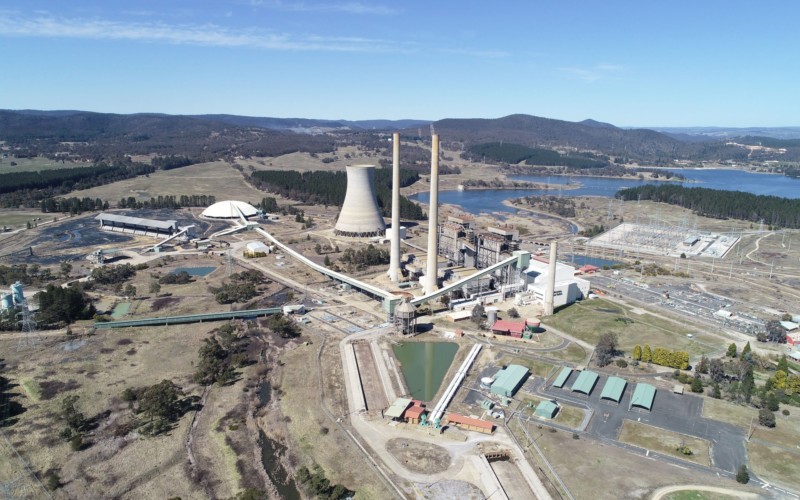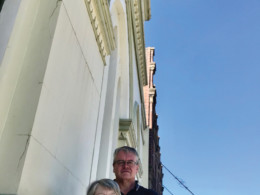Project proposed for old Wallerawang Power Station site has divided the community
Over 70 community members turned out on the Tuesday night of 26th for the Lithgow Council meeting. The public gallery was the largest in recent memory, and they were all here for the same thing. The rescission motion on Energy from Waste being bought forward by Clr Lesslie, Clr Coleman and Clr Mahony.
6 speakers spoke passionately about the project, very eloquently, and with what information they had a very firm view that they are right. However, out of the six speakers, 2 of them spoke in favour. The CEO of Greenspot, who’s support would clearly be anticipated, and a representative of the Wallerawang Lidsdale Progress Association.
“A just transition shouldn’t leave anybody behind,” said local resident, Ms Luka.
Ms Luka acknowledged that the community needs jobs, but they should not come with unacceptable costs in her view.
Representative for the Wallerawang Lidsdale Progress association, Mr Steven Jackson, said that his organisation would support the proposal if it can be proven to be safe, as there needs to be more opportunities for people. He hilighted the amount of apprenticeship opportunities that had vanished from the area as coal mines and coal fired power stations had closed in recent years.
The Rescission motion was then moved forward in the agenda so that it could be debated first, acknowledging that the vast majority of the attending audience were there for that item.
Ultimately, after debate on both sides of the argument, the rescission motion was defeated, voted for by Clr Lesslie, Clr Coleman and Clr Mahony, and against by the balance of the Councillors.
Clr Lesslie made it clear that there was serious health concerns in his view.
Clr Goodsell in speaking against the motion highlighted what she believed was a balanced approach from Council to conditionally support the EfW proposal.
This issue is a contentious one for the community, and there are pros and cons on both sides of the argument. Understandably, many residents are passionate about their end of the argument – potential health risks are a huge issue that needs to be addressed before any proposal could proceed. Any one who lives in this region, has children going to local schools would want certainty that this would be safe.
The question that needs to be addressed however is this – what is the main issue in regards to this proposal? Is it that burning waste in the minds of many presents significant health concerns for the community, or is it the origin of the waste? The idea of Sydney’s waste turning Lithgow into a tip for our eastern neighbours is not something that any of us would like to see. Would using our own landfills exclusively and dealing with our own waste issues be more acceptable?
If we view the waste problem from a bit higher view than our own backyards, there is additional context to this issue. The Sydney landfill situation is dire, the capacity to have any more landfill in the Sydney basin will be reached in 2028 at this stage. Regional landfills will not be far behind.
There are fears that burning the rubbish will slow down any recycling efforts, however, you only have to take a visit to Wallerawang or Portland tip on any given weekend to realise that, whilst we all have yellow recycle bins in our collection service, people are just not doing what they can now. Expecting any significant shift in the near future is unlikely.
Convenience and marketing are the biggest opponents to recycling as even the smallest item comes in a ridiculous amount of packaging. Waste is growing, not shrinking, because of these consumer driven ideals. The waste hierarchy addresses energy from waste as part of the solution of transitioning to a green energy future. However it assumes we are reducing, reusing and recycling as a priority and energy recovery is only being applied to the residual waste. That is the goal of a EfW facility, only burning fuel that has been sorted and processed.
There will be two things that occur between now and when any facility may actually break the ground; firstly, a full environmental impact statement would be part of the planning assessment which would allow the community, council and other stakeholders to make submissions on the proposal if and when it goes ahead.
Secondly, technology is constantly moving ahead in this space, energy and waste are two of the largest growth industries on the planet. There are significant opportunities in a range of energy generation technologies and these will accelerate in their development over the next few years, but short of perhaps nuclear technology, there is nothing that creates a baseload power.
There is no other technology however that can deal with the growing waste issue, generate significant baseload power and have other output by-products that have additional positive ongoing uses.
At this stage, the current facility used as an example produces a residual ash that can potentially be used in building materials or for other yet to be discovered products, which could be potentially manufactured in Lithgow. Cheap and reliable power is an enabler for these types of industries. In fact, cheap and reliable power is an enabler for almost any modern industry from data centres to specialised manufacturing.
There are already two large scale grid batteries proposed for the area, including one on the Greenspot site, but batteries do not produce energy, they store it.
Lithgow should be seen as the research and development powerhouse of a clean energy future and invite every technology proposal that does not represent a public or environmental health risk. It does not mean they need to proceed, but we should be aware of all the options.
Our region is transitioning, there is no question about that, however Lithgow has an asset that no other region has – a direct connection to the grid feeding the largest energy consuming market in the country. Lithgow should still be in the energy market, waste could be just one of those options.
The position taken by Council by voting down the rescission motion is not an approval of a facility. It is a support for Wallerawang Power Station site to be included in the Energy from Waste zone. There were also a number of other conditions forming part of that support, most of which would hope to ensure that the community has the best possible outcomes if a facility were to be proposed.
Think back just a decade and electric cars were a pipe dream, now every major manufacturer has a fully electric vehicle either in the market or in development. The same will be true of energy, and we will see over the coming years more efficient energy consumption as well as better technology for energy generation. The rapid rate at which these industries are evolving are leading to what many global experts are referring to as an Energy Abundance.
Lithgow needs to be part of Australia’s energy future, and this may be a first step to getting there. If we take this off the table and grid connectivity is re-routed away from this region, that infrastructure investment would mean it may never return to this region.
I have faith in technology, and if there is sound scientific proof that this facility can be operated with the health of our community residents and natural environment protected, then it should at least be on the table until something better comes along.
For people looking to learn more from Greenspot and Cleanaway on what is potentially being proposed on site, please visit the website www.greenspot.com.au/efw
For community members looking to get involved with the newly created Greater Lithgow Community Action Group, please contact Ann Thompson on 0417 946 415.










Rich – actually enjoyed reading this piece to bring clarity to the ‘vocal’ and often noisy meeting. I am afraid mate that this is where the agreement ends and as an ex power stn worker and concerned citizen who has done a ream of investigation and experienced these types of approvals first hand I think I can help you understand the real issues here.
1. The design – the latest proposal sitting in front of the EPA (after being denied as ‘not supporting the correct communities requirements) is 40 yr old technology and has been proven to be of limited ‘efficiency’ in a) limiting emissions and b) actually providing power to the energy grid. You see these things are ‘chain grate’ burner units which is to say the fuel (waste) is processed and laid on a ‘grate’ and burnt. The grate is in the ‘coldest’ part of a boiler and ‘ultimately’ requires support combustions fuels (in this case gas) to help the combustion process. To filter the gas the proponent is using a ‘fabric filter’ plant. I used to manage these at Mt piper and while they are effective, if properly maintained, at clearing a lot of dust they are less than useful for removing things like furans and dioxins – in this case the proponent is relying on a ‘second burn’ (more gas) and various chemical injections into the gas flow to ‘capture the poisons’ which will then be ‘disposed of’. Dioxins require temperatures of 1000 deg c to ‘break down’ and this process nominates a temp of 850 deg c for ‘at least 2 seconds’ to breakdown these items – this may be of limited effect when new but, as the plant ages, will be almost ineffective.
2. Fuels – you make the comment that the garbage will be ‘sorted’ for burning. Every enquiry and read world wide – cannot give me faith this is so. Municipal waste is, unfortunately, primarily made up of plastics (around 23%) and food waste ( 43%) and metals and woods (State Govt Waste Report 2022) and the food waste is 74% water moisture. If you have seen recycle bins – you should look at rubbish bins to see the putrid types of waste that, as you say, are to be sorted. Every article I have read states that “methods of effective sorting include, and are limited to, the removal of ‘non combustible material and timber. In essence metals and wood. There is no effective manner to sort out toxic matter because the people doing the sorting won’t be looking for ‘thick plastics’ , styrofoams etc. You have to remember here that the commercial effectiveness of this type of work is based on the time taken to do the sorting – thorough sorting takes time and time costs so, for mine, this stuff will be a quick scan over and a magnetic belt.
3. The wastes – you mentioned using the ‘bottom ash in concretes’ but this is not going to happen. I spent 8 years trying to get ‘clean’ ash into recycling and that job is hard. The issue here is liability and cement suppliers do not want to risk their own liability for a product they have no control on the manufacture I.e. they could not tell the generators how to fire the furnace and grind the coal (both impact on the particle size and composition of ash) so they wouldn’t use it – NOTE – I did negotiate a contract for 25000 tonnes a yr from Mt Piper but this was for treated flyash – piper also had a ‘Bessel block’ plant but, I believe it has been closed.
To expect these people to use a toxic mix of ash for structural bricks or concretes is ridiculous and will not happen. Also – keep in mind that bricks are extremely porous so blessed blocks with ash from these facilities will leach the encased toxins into the ground and people where they are used – I was involved in a number of csiro studies into this very subject.
4. Generating energy – a study in Europe showed that all the plants in the UK took energy FROM the grid rather than adding too the grid. This is because there is a lot of electrical equipment in the plants and they are not that efficient which means the steam they do make is low temperature steam rather than ‘superheated’ steam from a coal fired plant. What this means is that the generators will be very low capacity. In this study the investigators found that most plants would generate for there own needs and import around 41.3% from the grid.
So I hope you can see this is a far more complex problem than just ‘bring waste over the mountains to burn’.. The ‘thermal process’ for power is complex at the best of times but replacing a controllable fuel – such as coal – with a varied and toxic replacement is NOT, to my mind, the answer to this problem ..